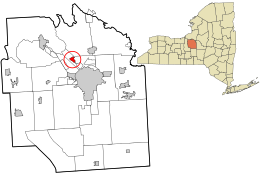Liverpool, New York
| Liverpool, New York | |
|---|---|
| Village | |
 Location in Onondaga County and the state of New York. |
|
| Coordinates: 43°6′12″N 76°12′24″W / 43.10333°N 76.20667°WCoordinates: 43°6′12″N 76°12′24″W / 43.10333°N 76.20667°W | |
| Country | United States |
| State | New York |
| County | Onondaga |
| Government | |
| • Mayor | Gary C. White |
| Area | |
| • Total | 0.8 sq mi (2.0 km2) |
| • Land | 0.8 sq mi (2.0 km2) |
| • Water | 0.0 sq mi (0.0 km2) |
| Elevation | 420 ft (128 m) |
| Population (2010) | |
| • Total | 2,347 |
| • Density | 2,900/sq mi (1,200/km2) |
| Time zone | Eastern (EST) (UTC-5) |
| • Summer (DST) | EDT (UTC-4) |
| ZIP codes | 13088-13090 |
| Area code(s) | 315 |
| FIPS code | 36-42884 |
| GNIS feature ID | 0955742 |
| Website | www |
Liverpool is a lakeside village in Onondaga County, New York, United States. The population was 2,347 at the 2010 census. The name was adopted from the city of Liverpool in the United Kingdom. The village is located on Onondaga Lake, in the western part of the town of Salina and is northwest of Syracuse, of which it is a suburb.
The area was originally inhabited by the Iroquois, starting in the 16th century. In the mid-17th century, Canadian French Jesuits visited the area, setting up missions. These were not very permanent, however. An example of these missions is Sainte Marie among the Iroquois, on Onondaga Lake just outside the village. Once the (Erie Canal)and (Oswego Canal)were built, the area was settled by Irish canal workers, Yankee settlers, and, later, German immigrants. The early recorded name for the village was "Little Ireland".
The Lucius Gleason House and Liverpool Cemetery are listed on the National Register of Historic Places.
Jonathan Danforth, brother of Asa Danforth, who was the founder of Onondaga Valley, was the first settler in the region east of Onondaga Lake which forms the village of Liverpool today. Danforth moved there in 1794 to manufacture salt.
Others followed soon after, including Patrick Riley, Joseph Gordon, James Armstrong and Charles Morgan.
By 1800, the area was a "sprightly little hamlet" and the scene of much bartering and trade. Local farmers preferred to market products in Liverpool and avoid the mud of lower Salina. After the Erie Canal (1825) and the Oswego Canal branch were opened, trade in the area quickly expanded and Liverpool had a reputation as a busy port community.
...
Wikipedia
